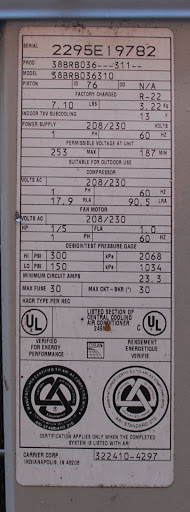iaov
Senior Member
- Location
- Rhinelander WI
Motors are not "different" . I still equals E over R or in this case over Z. Impedence is a vector sum of resistence and reactence in an AC cicuit. Inductive reactence depends on frequency not votage.
Why would it have less work to do? It is still getting the same frequency and trying to run at the same speed.If the work is also less to do,then the motor should be content with less current.
Impedance of a motor is a fascinating thing:it can represent external load on the motor as part of its resistive component.Due to this resistive component,the impedance of the motor depends on the applied voltage.Motors are not "different" . I still equals E over R or in this case over Z. Impedence is a vector sum of resistence and reactence in an AC cicuit. Inductive reactence depends on frequency not votage.
Why would it have less work to do? It is still getting the same frequency and trying to run at the same speed.
It does less work as the fan slows down. When you reduce the voltage to a normal blower motor it tries to run at the same speed. If it is running at the same speed the work is the same and the current has to go up. At some point the motor will no longer be able to run at the same speed as the "slip" will increase. When this happens the current will go down as the work is going down. I think that the work changes with the cube of the change in speed so a small reduction in speed will result in a large decrease in the work.Observe a ceiling fan provided with a speed regulator;observe current taken by the ceiling fan at minimum and maximum fan speed.Current will be less at minimum speed.Why?The fan load and hence the work done by the fan motor is less.
Vector sum of the angle of the bifocal times Z plus an inductive load vs. a resistive load = Motors are different.Motors are not "different" . I still equals E over R or in this case over Z. Impedence is a vector sum of resistence and reactence in an AC cicuit. Inductive reactence depends on frequency not votage.

Vector sum of the angle of the bifocal times Z plus an inductive load vs. a resistive load = Motors are different.
Yes, reluctance, resistance, impedance all equal R; but powering an incandescent bulb or resistive heating element vs. trying to start a motor on too low of a voltage is not the same.
I was looking for information on voltage drop formulas and stumbled on this discussion about motors. This is a concept I've been trying completey understand for years. I have heard so many people say "less volts=more current to a motor". I know that it's sometimes true, but they usually claim it is always the case. Obviously, reduced voltage starters are designed to reduce the startup current. Once the motor is at running speed, any reduction in voltage will reduce the amount of counter emf.......and so on. Sorry, just looked at the clock, late for work. It'll take me way too long to get this outta my head right now. Can someone steer me in the right direction here, will check back after work.
Think that one through a little bit.... he said i need a single phase "PHASE LOSE MONITER" .....
I was looking for information on voltage drop formulas and stumbled on this discussion about motors. This is a concept I've been trying completey understand for years. I have heard so many people say "less volts=more current to a motor". I know that it's sometimes true, but they usually claim it is always the case. Obviously, reduced voltage starters are designed to reduce the startup current. Once the motor is at running speed, any reduction in voltage will reduce the amount of counter emf.......and so on. Sorry, just looked at the clock, late for work. It'll take me way too long to get this outta my head right now. Can someone steer me in the right direction here, will check back after work.

